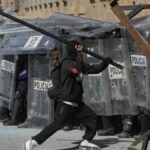Introduction
On October 3, 1968, Abel Quezada published a powerful cartoon in Mexico’s newspaper Excélsior, which poignantly questioned the state of their nation. Fifty-seven years later, Quezada’s words remain as relevant and impactful as ever, challenging readers to confront the harsh realities of their society.
The Power of Caricature
Throughout history, political cartoons have played a crucial role in highlighting and critiquing societal issues through striking visuals. Quezada’s simple yet profound cartoon, featuring a stark black rectangle, served as a powerful denunciation of the tragic loss of life and the government’s inaction following the Tlatelolco massacre.
The Tlatelolco Massacre
On the night of October 2, 1968, Mexican security forces violently suppressed student protests in the Plaza de las Tres Culturas (now known as Plaza de las Dos Culturas) in Tlatelolco, resulting in numerous deaths and disappearances. The event left an indelible mark on Mexico’s history, symbolizing the country’s struggle with violence and injustice.
The Enduring Legacy of Tlatelolco
Despite the passage of time, the memory of Tlatelolco remains vivid and essential to understanding Mexico’s ongoing challenges. The country grapples with the consequences of its inability to acknowledge and address violence, which has led to the erosion of the rule of law and the rise of organized crime.
- Ayotzinapa Case: The forced disappearance of 43 students in 2014 exemplifies the government’s failure to protect its citizens and uphold justice.
- Forced Recruitment: The practice of coercing individuals into joining criminal organizations highlights the breakdown of law and order.
- Criminal Training: The normalization of torture, organ trafficking, and human trafficking demonstrates the deep-rooted issues within Mexican society.
Vandalism at Tlatelolco: A Symbol of Resistance
The Centro Cultural Universitario de Tlatelolco stands as an emblematic symbol of peaceful resistance, historical struggle, and denunciation in Mexico. The recent vandalism at this site by a group known as “Bloque negro” raises questions about the perpetrators’ understanding of history and their disregard for cultural preservation.
Who are the Attackers?
According to Jacobo Dayán, director of the Centro Cultural Universitario Tlatelolco, the attackers are likely members of the “Bloque negro” group, which primarily targets the National Autonomous University of Mexico (UNAM). This incident should serve as a wake-up call for society, emphasizing the importance of safeguarding cultural institutions and knowledge.
Defending Culture: A Crucial Legacy
Although Mexico faces significant challenges related to violence and crime, citizens must continue to protect and champion their cultural heritage. By standing up against the vandalism at Tlatelolco, Mexicans can honor their past and work towards a more just future.






